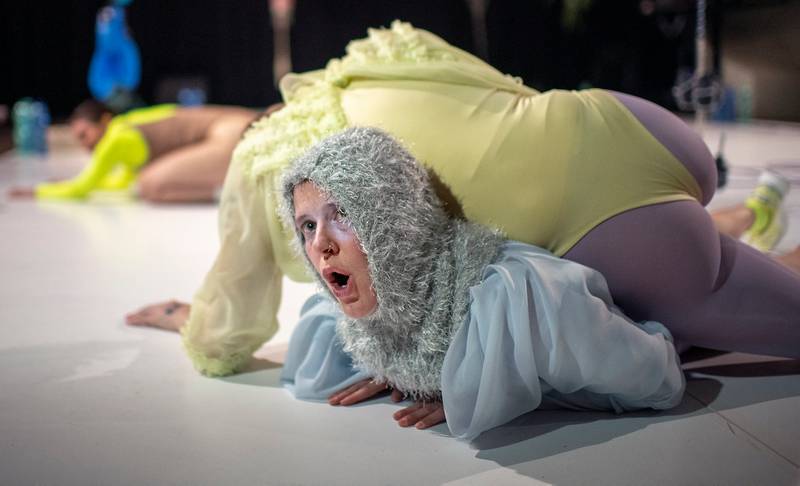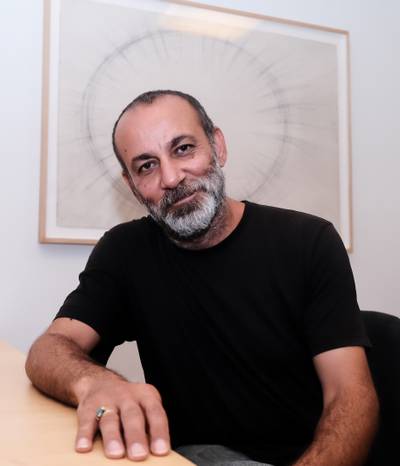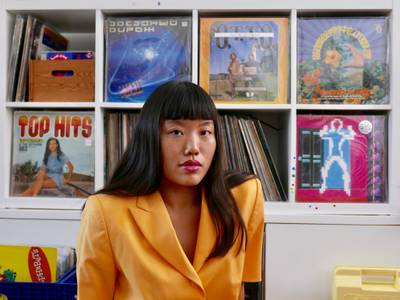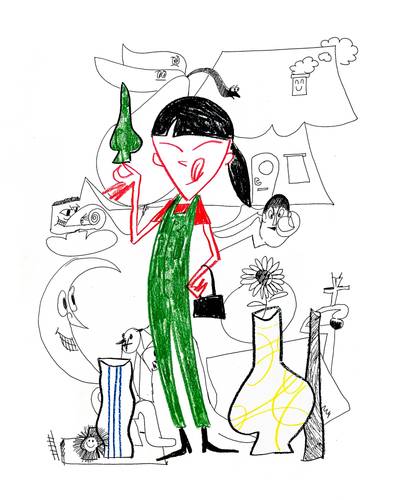

Teo Ala-Ruona, Camille Auer and Alvi Haapamäki from DTT working group
Francisco Rangel holds a bachelor’s degree in Media and Communication from Universidad Iberoamericana. He is currently a graduate student from the Master’s Programme of European and Nordic Studies and the Master’s Programme of Intercultural Encounters at the University of Helsinki.
On the eve of the day view of Deep Time Trans (DTT), the latest project by the DTT working group, I sat with two members of this collective of artists to discuss queer ecology, queer futures, and transformation. In Deep Time Trans, performers utilize play to evoke protoplasmic organisms that interact and replicate within non-binary ecosystems. By interchanging fluids, emulating unicellular organisms, and insinuating diffuse sexual exchanges, the performers explore pleasure and queerness at a cellular level. As only one part of a wider project that explores queer ecology, Deep Time Trans, is developed by the concerted work of Teo Ala Ruona, Even Minn, Camille Auer, Alvi Haapamäki, Eeti Piiroinen, Satu Kankkonen, Emil Santtu Uuttu, Olivia Pohjola, Pihla Lehtinen, and Riikka Thitz.
Although I only had the chance to speak with the two initiators of this project, Even Minn (writer and dramaturge) and Teo Ala-Ruona (writer and performer), they emphasised that this project was done collectively. Together, they produce performance, develop speculative fiction, and organize writing workshops on transfeminism, somatics, sexual and gender minorities, and queer ecology. I met them both in the DTT working group studio situated on the top floor of a building in Merihaka. Inside this massive building complex right in the middle of Helsinki, both artists opened up about their creative process and the transformative power of somatic practice in the theater. During our conversation, Even and Teo shared their thoughts on exploring natural history from a non-binary perspective, expressed the joyful experience of collaborating with their colleagues, and voiced their aim of exploring queer narratives as delightful experiences.
FRANCISCO: Can you tell me more about Deep Time Trans?
TEO ALA-RUONA: It started in 2019. We wanted to work around queer, ecological, and queer biological research done on evolution, and I guess ecology and biology in general. Our project was centered on asking how the history of biology is taught to us today by upholding certain kinds of cisnormative and heteronormative structures around all sorts of species, not only humans. And then we’ve been reading a lot all together and working with somatic practices and looking at the history of somatics. Specifically, how somatic history also has certain kinds of cis-normative structures. For example, how certain kinds of body parts are spoken about when somatic practices are done. We’ve been trying to develop trans-inclusive somatic practices within our process. Our whole project has two outcomes. The first one was a LARP. A Live Action Role Play called Deep-Time Transcestors for nonbinary trans and gender-nonconforming people, which was supposed to be out in 2020. Then COVID came, and now it’s been postponed, but hopefully it will happen next year. And then the second outcome is this performance.
And why do you think this sort of queer boom is happening in this day and age?
TAR: Queer boom?
Yeah, from academia to art, I would say even in pop culture, at least in the Western world, queer people are starting to be more recognized. And it’s a topic that is, I would say, I mean, I don’t want to use the word fashionable because it delegitimizes the movement, but it’s definitely something that is growing exponentially across the West. And I would say that in the Global South as well, but less.
Even Minn: Exactly, it’s not a fashion, but something that has just been discarded from the canon so much. For this reason, I wanted this piece to go as far back as possible, to kind of trace the lineages of queer people and have this connection to this very old history. So this project is really about history. And as for academia and art, I think they are related to the body somehow. For me, when I first started to use the word trans in relation to myself, I had the feeling that I was listening to my body, and it had a very experiential quality. And I think it’s not a coincidence that it’s a shared experience. I mean, the queer community is larger than the art world, obviously. But, this is a tough time for the world when, politically, there is some space for these kinds of truths to come out, such as the reality that gender is not binary. And it just, I don’t know, overlaps with many different realms, such as art, science, or everything.
TAR: I also think that there have been different waves or parts of queer history when certain kinds of aspects have been brought to the surface of political discussion. And I don’t consider it so that now we’re living in the outburst of something. But rather, I think that this is just a part of a history that has had different kinds of phases and stages. So I think that, overall, in academia, or in the art world, or in the political spheres, there is, at the moment, more information and knowledge around feminist intersectional thinking.
I wanted to go into the word trans. How do you understand it in your work?
EM: Well, fantasy and speculative fiction are really important to us in this performance and in our past work. In our previous performance, which was a solo by Teo called Toxinosexofuturecumings, there’s this quote about trans described etymologically as “elsewhere.”
TAR: Yeah, I also thought that through somatic practice, you can recognize the importance of the word trans. As such, the basic meaning of somatic practice requires that you work with your bodily experiences, delving into them quite deeply, and work with whatever is happening internally in you. From my own perspective, I think that in somatic practices I can somehow tap into the reality of my body being what it is, which is an experience totally different from what the social structures think that I am.
For me, the term ‘queer’ is quite fundamental, and it is related to anticapitalism, changing structures, and changing society at large.
How do you conceive the word ‘queer’ in this art piece? As you know, this word is used as an umbrella term but is also utilized to describe identity and delimit the ambivalence of gender. So how did you build upon that?
EM: Yeah, I’m still thinking about queer as a fashion. I think the word ‘queer’ gets thrown around a little bit. I have conflicted feelings around this. For me, the term ‘queer’ is quite fundamental, and it is related to anticapitalism, changing structures, and changing society at large. And I feel like, in the art world, it’s very identity-centered. Maybe not even identity-centered, but mainly focused on aesthetics, so I find it very hard to kind of wrap my head around it. But for sure, the word ‘queer’, for me, also means a community of queer people. Yeah, that’s what it means to me.
TAR: I guess that, for me, the word ‘queer’ is always related to its history. And it is a history of humans and certain humans that deviate from certain kinds of norms that became more solid during a certain part of history. And then, I think queer is always related to bodies, gender, and sexuality. For example, when talking about queer ecology, or queer biology, we are also talking about the sexuality, gender, or sex of certain kinds of species. Although for me, the word ‘queer’ can be a way of thinking, or it can be your way of relating to the world, or whatnot, in the end, it needs to relate to its history. And that is the history of people who have certain kinds of gender or sexual identities. In the art world, for example, you often hear about some pieces being read as queer, as if a certain kind of aesthetic would mean queer, which I somehow don’t like: I can’t really connect with that idea. I think the word ‘queer’ has its own history, and it is related to certain kinds of violence and specific kinds of bodies being policed and violated.


“Deep Time Trans” working group on stage
So, in that sense, your piece intends to delve historically with queer bodies and time?
TAR: Well, if we look at our working process, we’ve been dealing with queer texts that delve into queer ecological and queer biological topics. Then our working group consists mainly of people who identify as queer or have knowledge about living in the queer margins of society. Then, thematically and artistically, I guess we are dealing with the prehistory of life. We’ve been working with LARPing and playing as multicellular or single-cellular life that reproduced without gender on earth since 4 billion years ago, before the notion of queer ever existed.
Are you longing for a world where queerness is a hegemonic norm?
TAR: I wouldn’t simplify it like that. In our pieces, we’ve been working quite a lot with the concept of futurities. And in this one, we especially wanted to look backward and see how we could speculate on episodes that happened in the past, not only speculating or dreaming of what could happen. Our interest in this work relies on the idea that the creation of new life is not sustained by sexual selection or the survival of the fittest. Instead, we think that life reproduction is based more on enjoyment, community building, being with one another, sexual indulgence, and pleasure in general, and not certain kinds of heteronormative ways of reproducing life. But I wouldn’t say that we have some sort of political agenda, and also, we don’t want to demolish everything. Speculating with the idea of a historical time where there wasn’t such a thing as a gender structure or gender binaries, I mean, that’s an interesting thing to think about, but it’s quite impossible at the same time. However, if I think of the first fish in the primordial seas or lizards, I guess there was no such thing as marginalized fish being violated due to their certain sexual behavior. So yeah, I guess I long.
From the very early stages of the work, we have agreed that we are not doing pedagogical work. However, we hope that the audience can experience us performers enjoying ourselves and each other on stage and witness how we play on stage, not as in a theater play but as in how children play.
Are you looking at the past to search for an alternative for the future?
EM: Sonya Lindfors, who is a choreographer in Helsinki who does amazing work, has stated the obvious, that art is very communal. In that regard, I often think that what happens on stage is real-life, even though it’s art. By doing that, we can take it seriously when we visit the past history of the world on stage, because we are actually reproducing and letting the audience see something in the present moment. In that way, the past becomes the future, and the future becomes the past in the present. And it’s all like, happening there, on the stage. I think, for me, the stage brings everything into the present. I think it’s so much fun to think about the prehistoric world. And somatically, I’m just wondering whether we are dreaming of a world where these bodies are occupying space or not. Well, for me, I think we are prehistoric beings. Inside of us, there are these, like cellular and bodily patterns, which are alive in the present moment. So this performance is not actually about imagining the future or looking at the past. It’s just about the actual connection between the performers in the present moment.
And, what would you hope people learn or feel in your performance?
TAR: From the very early stages of the work, we have agreed that we are not doing pedagogical work. However, we hope that the audience can experience us performers enjoying ourselves and each other on stage and witness how we play on stage, not as in a theater play but as in how children play. Also, we want the audience to see that we are caring for one another. Then, personally, I also wish that the audience could get some bodily shivers or physical sensations, but that’s just my personal wish.
EM: I want the audience to see our piece as a looking glass to abundance, entropy, and chaos as a place of life to develop and die and live and die and evolve. Also, I want the audience to wonder with us at the queer evolution, deaths, and births of the universe as they unfold on stage.


Aqua Queer Futures as represented on stage
On that evening, I had the pleasure of experiencing Deep Time Trans at the Baltic Circle Festival in Tiivistämö. Despite the unusual nature of this artwork, the sensation evoked by the performers was inherently familiar to every spectator. The DTT working group portrayed a world where creation is enacted by pleasure and protoplasmic interaction. For 70 minutes, performers depict a reproductive ecosystem without recurring to the symbolism of sexual organs. Instead, the working group of artists employed bodily fluids and kinesthetic interaction to draw on evolution from a queer perspective. However, the most remarkable aspect of this work is the joy with which this piece is performed. It is rare to encounter artwork that delves into the positive side of queerness, but it is even more rare to see performers having fun on stage and understanding each other.







